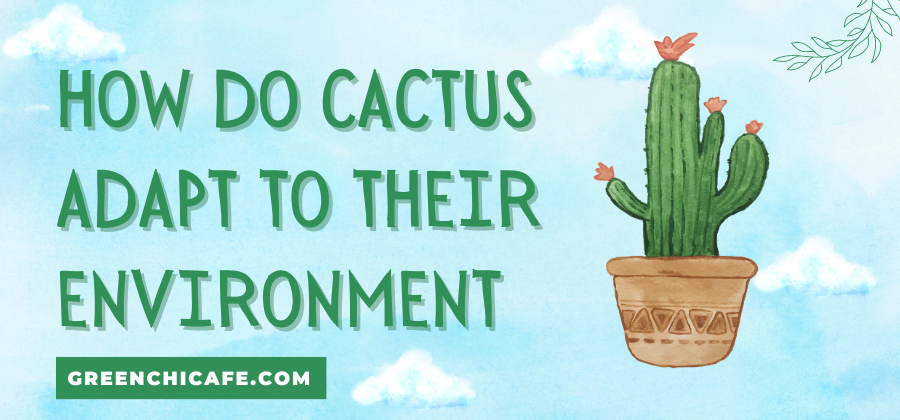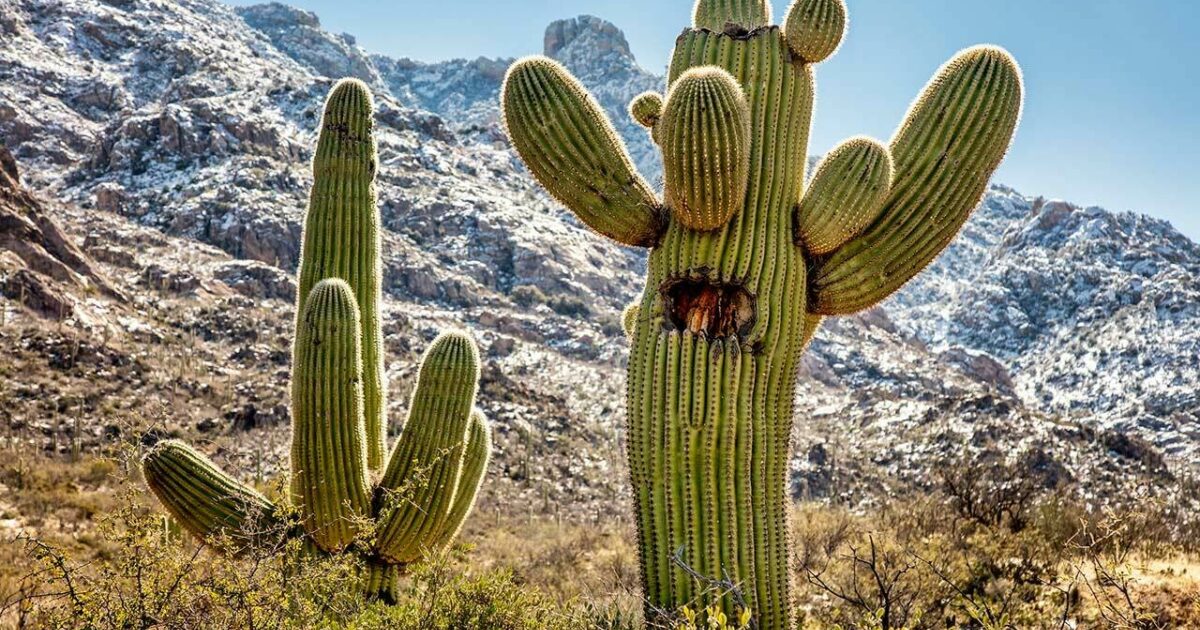Cacti have evolved incredible adaptations to survive in harsh desert climates.
Learn how these succulent plants conserve water, protect themselves, and interact with desert ecosystems.
This article explores the various structural and behavioral adaptations that allow cacti to thrive in arid environments.
How Do Cactus Adapt to Their Environment?
Cacti are uniquely adapted to survive in hot, desert climates.
Their specialized morphology and physiology allow them to thrive where most other plants cannot persist.
Key Points
- Cacti store water in their thick, succulent stems to survive long droughts.
- Their waxy skin and lack of leaves prevent water loss through transpiration.
- Spines and glochids protect cacti from desert herbivores.
How do cacti store water in their stems?
Cacti can survive for long periods without rain due to their ability to store water in their thick, succulent stems.
The stem acts as a reservoir, swelling as it fills with water and shrinking as water is used for photosynthesis and transpiration.
The outer skin of the stem is also covered in a thick, waxy cuticle that helps prevent loss of moisture through evaporation.
Some species have ridges along their stems which can expand like accordions, allowing the cactus to rapidly absorb water when it rains.
The spongy inner stem tissue stores water more efficiently than normal plant cells.
All these adaptations allow cacti to conserve as much precious water as possible in anticipation of months or years without rainfall.
What structural adaptations prevent water loss in cacti?
In addition to their succulent stems, cacti have several other structural adaptations to prevent water loss in the desert environment.
Their leaves have been modified into spines which greatly reduces the amount of surface area for transpiration.
Photosynthesis is carried out by the green stems instead.
The few leaves which are present are small, thick, and coated with waxes.
Cacti also have a very shallow, widespread root system that quickly absorbs water when it rains before it can evaporate.
Their stomata, or pores, only open at night to allow gas exchange when temperatures are cooler and moisture loss is reduced.
All these adaptations help cacti conserve water in the hot, desert climate.
How do spines and glochids protect cacti?
The sharp spines and glochids of cacti serve an important protective purpose in deterring herbivores in the harsh desert environment.
The long, hardened spines can puncture and injure animals that attempt to eat the cactus.
Glochids are tiny, hair-like spines that form dense clusters on young cacti and detached segments.
These easily detach from the plant and embed themselves in animal skin and mucous membranes.
The irritation and discomfort caused by the spines and glochids provide an effective defense, preventing most animals and insects from consuming the cactus.
Their specialized morphology allows the plant to conserve energy and resources instead of producing complex toxins.
The spines grow from specialized structures on the plant called areoles which also give rise to flowers and branches.
How do cacti attract pollinators and seed dispersers?
In the hot, desert, cacti face challenges attracting pollinators and animals to disperse their seeds.
They have formed symbiotic relationships with specific animals to facilitate these processes through unique adaptations.
Brightly colored, showy flowers provide nectar rewards to attract pollinating insects and birds.
Some species even time their flowering at night to draw in nocturnal moth pollinators.
The edible, fleshy fruit produced by cacti appeals to desert animals who then ingest and spread the indigestible seeds.
Adaptations like these allow cacti to efficiently reproduce in challenging environments.
Some species also provide food or shelter to animal partners in return for their pollination services.
How does camouflage help cacti survive?
Many cacti employ camouflage to avoid being eaten by blending in with the desert background.
Their green stems allow them to blend in with surrounding vegetation while their spines resemble the thorns of other plants.
Some species have reddish or brownish spines that match the desert soil and rocks.
Small, ground-hugging cacti escape the notice of herbivores through their low-growth form.
Others have tubercles and ridges on their stems that break up their outline and resemble natural rock formations.
Some globular cacti even have grooves and markings on their spherical stems that cause them to resemble stones.
Camouflage provides an important passive defense for cacti growing in exposed desert environments.
How do cacti interact with the desert ecosystem?
As vital components of desert environments, cacti contribute to ecosystem functioning in various ways.
Their flowers provide nectar that sustains populations of pollinating insects and birds.
Fruit-eating animals rely on the cacti for food and disperse their seeds.
Cactus spines shelter small animals from predators while fallen leaves and stems decay and return nutrients to the soil.
Cacti also provide food, shelter, and moisture for organisms living on their stems.
Some species host nitrogen-fixing bacteria in their roots, enriching nutrient-poor desert soils.
Cacti help stabilize soils and limit erosion with their extensive root networks.
As drought-resistant plants, cacti are important indicators of desertification.
Overall, cacti play integral ecological roles in desert habitats.
How does habitat influence cactus adaptations?
The specific desert habitat shapes the specialized adaptations seen in different cactus species.
For instance, cacti growing in warmer, drier areas have more ribs and folds for faster water uptake and minimized surface area.
Southwestern U.S. species tolerate more intense heat and sunlight than cacti from cooler, cloudier deserts.
Coastal cacti have smaller, softer bodies with more mucilage to resist salt spray.
Cacti in rocky soils are shorter with corkier stems and smaller root systems.
Species relying on specialized pollinators have showier flowers and greater nectar rewards.
Highly specific symbiotic relationships drive adaptations like fruit color and flavor preferred by local seed dispersers.
The climate, terrain, and ecological community all influence cactus adaptations.
What are the 5 adaptations of a cactus?
Cacti have numerous structural and behavioral adaptations that allow them to survive in arid desert environments.
Five key cactus adaptations include:
- Succulent stems – Cacti have thick, water-storing stems covered with a waxy cuticle to prevent water loss. The spongy inner stem tissue stores water efficiently.
- Reduced leaves – Leaves have been modified into spines to minimize surface area for transpiration. Photosynthesis occurs in the green stems.
- Shallow widespread roots – The roots extend horizontally near the soil surface to quickly absorb rainfall before it evaporates.
- Spines – Sharp spines cover the stem surface and deter herbivores from consuming the cactus.
- CAM photosynthesis – Cacti uses crassulacean acid metabolism to fix CO2 at night, reducing water loss. Stomata stays closed during the day.
These morphological and physiological adaptations equip cacti to conserve water, protect themselves, carry out gas exchange, and survive extended drought periods in desert environments.
Their specialized structures and processes allow cacti to thrive where most other plants cannot.
What are cactus adaptations examples?
Here are some examples of adaptations seen in different cactus species:
- Barrel cacti have pleated, accordion-like stems that can expand and contract to rapidly absorb water when it rains.
- Prickly pear cacti have flattened, pad-like stems containing water-storing tissue to reduce surface area and minimize water loss.
- Old man cacti have developed long, white hairs that shade the stem and camouflage the plant against its desert surroundings.
- Some cacti like the senita have corky, waxy stems that help retain moisture and protect the cactus body.
- Ocotillo cacti have an extensive but shallow root system that extends up to 50 feet from the base of the plant to capture ephemeral rainfall.
- Many cacti produce zig-zag stems or grow close to the ground to provide stability in their often rocky and exposed habitats.
- Brightly colored fruits and flowers attract pollinators and seed dispersers necessary for cactus reproduction in arid environments.
How is cactus adapted to survive in water?
While most cacti thrive in desert environments, there are some specialized species adapted to live in tropical areas with high rainfall.
These cacti grow along river and lake margins, flooded forests, mangroves, and other wet areas.
Some adaptations that help tropical cacti survive in aquatic and semi-aquatic habitats include:
- Reduced or absent spines – The lack of sharp spines reduces injury and drag in water.
- Smooth, flexible stems – Their stems bend and flex with water currents rather than breaking.
- Corky stems – Lightweight corky tissue provides buoyancy and reduces water-logging.
- Sediment roots -Specialized roots grow from the stem, anchoring the cactus in soft sediment.
- Floating stems – Some tropical cacti have stems that float on the water surface for dispersal.
- Reduced transpiration – Their skins still conserve moisture despite the wet habitat.
While adapted for deserts, structural modifications allow some cacti to inhabit tropical wetland environments.
In Summary
Cacti are amazingly well-adapted to survive in harsh desert environments.
Their specialized morphology and physiology allow them to store water efficiently, prevent water loss, deter predators, attract pollinators, and interact with the ecosystem.
Different cactus adaptations are shaped by the specific conditions and selective pressures of local habitats.
The remarkable adaptations of cacti enable them to thrive where few other plants can persist, making them icons of the desert.
Frequently Asked Questions
What adaptations help cacti thrive in deserts?
Key adaptations include succulent stems for water storage, waxy skin to reduce transpiration, spines for protection, and shallow spread roots for quick water absorption. Their photosynthesis is carried out by green stems which have less surface area for water loss than leaves.
How does the desert habitat influence cactus adaptations?
The specific climate, terrain, and ecological community shape cactus adaptations. For example, cacti in drier areas have more ribs and folds for quick water uptake while species in rocky soils are shorter with corkier stems.
What ecological roles do cacti play in the desert?
Cacti interact with desert ecosystems by providing food and shelter for animals, stabilizing soils, and enriching nutrient-poor sands. Their flowers sustain pollinators while their fruits feed seed dispersers.
What causes the variations in cactus adaptations?
Different cactus species exhibit unique adaptations based on the specific conditions where they live. The climate, soil, pollinators, and herbivores of local habitats drive specialized adaptations.
At GreenChiCafe, we are passionate about educating people on the natural world and environmental issues. Please check out our website for more content on ecology, sustainability, and how you can help protect our planet.

Annie is a passionate environmental writer and activist. She has been writing about sustainability, conservation, and green living for over 15+ years. Annie is dedicated to raising awareness about environmental issues and providing practical tips for living an eco-friendly lifestyle. When she’s not writing, you can find her volunteering with local environmental organizations, teaching workshops on zero waste living, or exploring nature. Feel free to get in touch with Annie: annie@greenchicafe.com

